| |
| |
|
|
|
|
|
| |
| November 9, 2009 |
|
Lee Creek vols 1 & 2
In case you don't have a copy, I just noticed that the Smithsonian now has Lee Creek 1 and 2 available as a .pdf download. Go to their Contributions site and type Lee Creek into the search box.
|
| August 5, 2009 |
|
Megamouth Paper
After a couple years of research, Pieter DeSchutter's Megachasma study has finally been published. This paper reports on Megamouth teeth from Europe and integrates them with those from the Western Atlantic, California and Chile. Geologica Belgica has this paper (The presence of Megachasma (Chondrichthyes: Lamniformes) in the Neogene of Belgium, first occurrence in Europe.) available as a PDF from its website.
|
| August 4, 2009 |
|
Shark Rostral Nodes
A couple years back, Harold van der Steen (a Netherlands reader and Lee Creek collector) wrote me looking for information on shark rostral nodes -- it seems fellow collectors didn't believe in the notion. I was unable to help him with his follow-up question - what species? I concluded my remarks with 'good luck, not in our lifetime'. Well, Harold finally found someone to go that extra mile and attribute that Dutch specimen to Lamna nasus. Geologica Belgica has made Frederik H. Mollen's paper (A partial rostrum of the Porbeagle shark Lamna nasus (Lamniformes, Lamnidae) from the Miocene of the North Sea Basin and the taxonomic importance of rostral morphology in extinct sharks) available as a PDF (1.7 mb) available from its website; certainly worth the read.
[Go to Geologica Belgica
| select "NOUVEAU: Geologica Belgica ON LINE" link
| and from that page "Access to the journal".]
|
| July 21, 2009 |
|
No Fall 2009 Season
Curtis sent me one of those notes today we all hope not to receive.
I hate to bring bad news, but the 2009 fall fossil hunting season has
been canceled. We are preparing to start running a fleet of haul trucks
throughout and in the area of the fossil hunting ramp. Plans are to move
over 5 million cubic yards of material with these trucks. With the
increased amount of truck traffic all the area and to include the area
setup for fossil hunting will be closed until further notice.
I am very sorry to have to be the bearer of bad news, but hope the hunters
understand and we will keep everyone notified of any changes. Thanks.
Curtis Ormond
Public Affairs
PCS Phosphate
|
| May 24, 2009 |
|
Festival Volunteer Hunt
Pat Young reports: The hunting party wasted little time in getting the obligatory paperwork completed; thankfully, the MSHA safety lecture was delivered without embellishments. Six and one half inches of rain had fallen since the last hunt so expectations were high. A few rain sprinkles fell throughout the day but cloudy skies and a soft breeze kept us comfortable.
Surprisingly, only two giant Carcharocles megalodon were reported; Tony Holt's black reworked tooth measured 5-7/8 inches! Matt Howard found the two halves of his 6-1/4" tooth 25 feet apart on opposite sides of a gully. Other smaller megs were found by BJ Blake, Kathy Young, Dave Sandersn and others. Nearly everyone had one or more large Yorktown "mako" teeth to show; the lower anterior tooth of Brian Roberts was especially pretty.
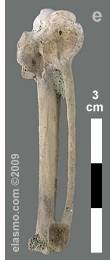 Four pathological teeth were found; two with a split tip and two with badly twisted crowns. At nearly two inches, Doug Chaussee's Hemipristis tooth was the largest seen this season. Notorynchus teeth were in nearly every collection; Shannon Roberts showed the only symphyseal and Trish Kohler (fig. A) the only upper tooth. One lucky person got three complete Carcharoides catticus teeth (my rain-wet tablet deleted their name). A generous collection of all other shark teeth was reported. Whale teeth had finally made an appearance; at least four sperm whale type teeth were found. Squalodon was best represented by Dawn Moesteller's incisor and Rocky Culbertson's molar (fig. B). Eric Sadorf got a pretty yellow cf.Tretosphys (fig. C) and Scott Kuslugh a Delphinodon dividum posterior tooth. Dan Furimsky's tooth, a heavy black specimen, measured nearly eight inches. Nando Musmarra found a large section of whale skull with the periotic intact. Fossil seal hunters did well with several leg and flipper bones; molars were reported by George Powell and Kevin May (fig. D). Bird bones were found by Trish Kohler (Alca antiqua, tarsometatarsus) and Sandy Shelton (a spectacular carpometacarpus, fig. E); she also found the only piece of Pungo amber. Candace Holliday showed off a nice crocodile tooth. Karissa Hendershot and Doug Chaussee each found large shark vertebrae that showed a peculiar arthritic-like growth; Doug's specimen contained two fused vertebrae. Fish fossils were the most prolific they had been all season. If this area remains open for a fall season, it should become even more rewarding to fossil hunters. Four pathological teeth were found; two with a split tip and two with badly twisted crowns. At nearly two inches, Doug Chaussee's Hemipristis tooth was the largest seen this season. Notorynchus teeth were in nearly every collection; Shannon Roberts showed the only symphyseal and Trish Kohler (fig. A) the only upper tooth. One lucky person got three complete Carcharoides catticus teeth (my rain-wet tablet deleted their name). A generous collection of all other shark teeth was reported. Whale teeth had finally made an appearance; at least four sperm whale type teeth were found. Squalodon was best represented by Dawn Moesteller's incisor and Rocky Culbertson's molar (fig. B). Eric Sadorf got a pretty yellow cf.Tretosphys (fig. C) and Scott Kuslugh a Delphinodon dividum posterior tooth. Dan Furimsky's tooth, a heavy black specimen, measured nearly eight inches. Nando Musmarra found a large section of whale skull with the periotic intact. Fossil seal hunters did well with several leg and flipper bones; molars were reported by George Powell and Kevin May (fig. D). Bird bones were found by Trish Kohler (Alca antiqua, tarsometatarsus) and Sandy Shelton (a spectacular carpometacarpus, fig. E); she also found the only piece of Pungo amber. Candace Holliday showed off a nice crocodile tooth. Karissa Hendershot and Doug Chaussee each found large shark vertebrae that showed a peculiar arthritic-like growth; Doug's specimen contained two fused vertebrae. Fish fossils were the most prolific they had been all season. If this area remains open for a fall season, it should become even more rewarding to fossil hunters.

As spring season ends, we'd like to say a generous thanks to Curtis Ormond for requesting and organizing these fossil trips, to Tex Gilmore for going the extra mile to insure the ramp was kept in good condition and to Rob Jenner and Jerry Waters for their continued support of our quests. Candace Holliday kept us supplied with extra cool water on those almost unbearably hot days and Becky was always available to help identify those marine mammal bones. Thanks to all the fossil collectors for making this a safe season.
|
| May 23, 2009 |
|
Festival Weekend
 Pat Young reports: After months of planning, the 16th Annual Fossil Festival kicked off Friday night with the announcement of this year's Fossil Master. We heartily applaud the festival committee in their choice of Candace Holliday (image) for this honor. Candace has been around the fossil scene for as long as most of us can remember and has worn many hats. A former Aurora Fossil Museum Director, her more recent pursuits include bus driving duties for our weekly collecting trips in the mine. Congratulations, Candace! Pat Young reports: After months of planning, the 16th Annual Fossil Festival kicked off Friday night with the announcement of this year's Fossil Master. We heartily applaud the festival committee in their choice of Candace Holliday (image) for this honor. Candace has been around the fossil scene for as long as most of us can remember and has worn many hats. A former Aurora Fossil Museum Director, her more recent pursuits include bus driving duties for our weekly collecting trips in the mine. Congratulations, Candace!
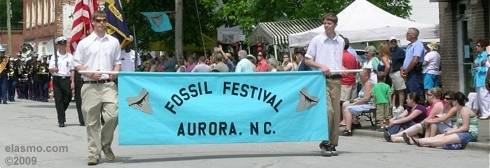
On Saturday, Aurora's streets filled early as the Annual Fossil Festival kicked into full steam. A parade honoring veterans featured the Marine Corps Band (image) playing patriotic songs. Visitors showed their appreciation by standing and clapping until the band was well out of sight.
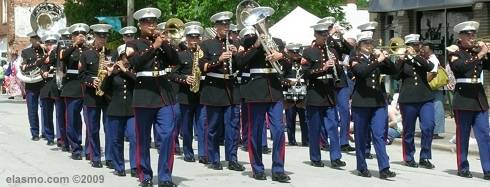
Scents of Polish sausage, soft-shell crabs and blooming onions filled the air while sounds of every type of music kept toes tapping. Fossil vendors had a wide variety of wares at reasonable prices; "meg" teeth were the most popular with mineral specimens a close second. Several fossil clubs (Aurora Fossil Club, American Fossil Federation, North Carolina Fossil Club) and others, the Schiele Museum, North Carolina Museum of Natural Sciences, Virginia Museum of Natural History and the Smithsonian Institution displayed their fossils, gems and minerals and assisted visitors with fossil identification. The Education Tent had exotic snakes that could be handled, a lively barred owl, huge modern sperm whale jaw, sea turtle skull, Civil War and Native American relics and unusual fossils from the Calvert Marine Museum and Friends collection. Lectures at the museum were presented by Billy Palmer (ancient whales), Vance McCollom (Pleistocene land mammals) and Dr. Bret Kent (updated info on Parotodus benedini). Those looking for more active adventures found it at lawn mower races, hot air balloon rides and picking shark's teeth from the many fossil piles around town. The Aurora Fossil Museum's annual fossil auction appeared to do brisk business as auctioneer Jay Goldberg kept bidders alert and competitive. Volunteers are the backbone of the festival and this year's group, after a week of very hard work, was rewarded with a special fossil hunt at PCS Phosphate.
|
| May 10, 2009 |
|
Weekend 11 - A slow end
Pat Young reports: This week's heavy storms produced over four inches of rain and provided a unified vision for today's group -- big shark teeth. Members of the Montgomery Co. Gem and Mineral Society (VA), NY Paleontological Society, Smithsonian Institution volunteers and several others wasted no time in completing paperwork and boarding the "fossil" bus. In spite of high 80s temperatures and humidity to match, we were kept comfortable by a steady breeze all day. The recently installed pumps (thanks PCS!) are working just fine and we had mostly dry access to the collecting area.

 Big Yorktown megs were found, approximately eight to ten. Unfortunately, all but one suffered major damage. Dan Pierson got the largest at 4-3/4 inches but it was missing a chunk from the side of the cusp. Eric Sadorf found a large pathological tooth (the tip resembled a Physogaleus contortus), but it was missing the root. Others had similar luck -- beautiful but partial teeth. Only Tracy Mayo came away with a complete meg, a 3-1/2 inch upper lateral. Linda Wooten got the largest of several black Pungo teeth recovered. Kevin Wilson found an attractive posterior tooth with gray crown and black root. Several complete chubutensis were also found; Jennifer Weinberg's was largest. Cosmopolitodus teeth have been very numerous this season and today was no exception; it's not unreasonable to assume that everyone got at least a couple of nice ones. Notorynchus teeth made a great showing this week; Betty McComber's (image) is representative of the quality of most. Becky Hyne and Steve Noel caused a few gasps of envy -- Becky got a perfect yellow Echinorhinus and Steve the second Megachasma of the season. Not willing to risk losing these teeth to the high winds, no images were made.
Big Yorktown megs were found, approximately eight to ten. Unfortunately, all but one suffered major damage. Dan Pierson got the largest at 4-3/4 inches but it was missing a chunk from the side of the cusp. Eric Sadorf found a large pathological tooth (the tip resembled a Physogaleus contortus), but it was missing the root. Others had similar luck -- beautiful but partial teeth. Only Tracy Mayo came away with a complete meg, a 3-1/2 inch upper lateral. Linda Wooten got the largest of several black Pungo teeth recovered. Kevin Wilson found an attractive posterior tooth with gray crown and black root. Several complete chubutensis were also found; Jennifer Weinberg's was largest. Cosmopolitodus teeth have been very numerous this season and today was no exception; it's not unreasonable to assume that everyone got at least a couple of nice ones. Notorynchus teeth made a great showing this week; Betty McComber's (image) is representative of the quality of most. Becky Hyne and Steve Noel caused a few gasps of envy -- Becky got a perfect yellow Echinorhinus and Steve the second Megachasma of the season. Not willing to risk losing these teeth to the high winds, no images were made.
First-time Aurora collector, Sharon Devore, got a few quick fossil hunting tips from George Powell and then proceeded to find a pristine Squalodon incisor (image). Eric Sadorf's brown cetacean periotic (image) in matrix was a nice display piece. Fish fossils, previously scarce, showed very well this week in the still damp hills. Large tuna vertebrae, tuna mandible, anglerfish jaw, partial upper marlin beak, and some large hakefish jaws (as well as many smaller vertebrae and a few caudals) were collected. Jeff Sparks and Merrill Mille (image) each found nice ray scutes. At day's end, burrfish mouths and bonita noses still littered the mine.
There are no fossil trips scheduled for next weekend.
|
| May 3, 2009 |
|
Weekend 10 - Open for business
Pat Young reports: With the mine having been unavailable for fossil collecting the past two weeks, Saturday morning's parking lot crowd was rather excited. Word quickly spread--the ramp road [image] had been repaired the previous week and future plans included a pumping station to help insure our continued access. This was especially welcomed news to those who had already been cancelled this season. The weather forecast included possible showers (there had been no rain since the closing) both days but mid-eighties temps and a brisk breeze made for excellent hunting conditions. Members of the Ft. Fisher Aquarium (NC), Suanee River Fossil Club and Maryland Geological Society joined individual collectors this weekend.

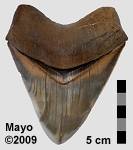 A trip down the new roadway got Eric Sadorf a 5-inch Carcharocles megalodon. Clay Whitehurst spotted just the tip of his 5-1/2 inch reworked one and Chris Mayo put his digging skills to work to find a large Yorktown tooth [image]. Steve Ferguson celebrated his first trip to Aurora by finding a shiny black 3+ inch chubutensis; a bit of root damage did little to detract from the beauty of the tooth. Other nice megs and chubbies were found by Louise Crain, Virginia Kossol, Dan Lawver, and Mary Kay Furimsky. Great whites (Carcharodon carcharias) seemed abundant by Aurora standards; at least seven were found. Dave Sanderson' upper [image] and Bob Willke's lower [image] were the largest; others were found by Tony Zollo, Reggie Titmas (2), Joe Ferguson and Rodney Battenfield. "Makos" of all types had a nice showing -- Saturday's crowd seemed to find Pungo examples while Sunday's hunters showed mostly Yorktown. Yvonne Kerek got a large upper lateral Cosmopolitodus hastalis from the bulldozer tracks and Joe Ferguson an Isurus retroflexus (minus most of its root). Becky Hyne's Pungo crawl netted her a perfect Squatina.
A trip down the new roadway got Eric Sadorf a 5-inch Carcharocles megalodon. Clay Whitehurst spotted just the tip of his 5-1/2 inch reworked one and Chris Mayo put his digging skills to work to find a large Yorktown tooth [image]. Steve Ferguson celebrated his first trip to Aurora by finding a shiny black 3+ inch chubutensis; a bit of root damage did little to detract from the beauty of the tooth. Other nice megs and chubbies were found by Louise Crain, Virginia Kossol, Dan Lawver, and Mary Kay Furimsky. Great whites (Carcharodon carcharias) seemed abundant by Aurora standards; at least seven were found. Dave Sanderson' upper [image] and Bob Willke's lower [image] were the largest; others were found by Tony Zollo, Reggie Titmas (2), Joe Ferguson and Rodney Battenfield. "Makos" of all types had a nice showing -- Saturday's crowd seemed to find Pungo examples while Sunday's hunters showed mostly Yorktown. Yvonne Kerek got a large upper lateral Cosmopolitodus hastalis from the bulldozer tracks and Joe Ferguson an Isurus retroflexus (minus most of its root). Becky Hyne's Pungo crawl netted her a perfect Squatina.

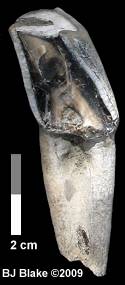 Other than vertebrae, cetacean fossils have been scarce. However this weekend, Reggie Titmas recovered a partial Squalodon whitmorei jaw including sockets for anterior and molar teeth (he also found some loose but presumed associated teeth). George Powell got a whale jaw with two partial teeth and Steve Ferguson took home a small, nearly complete (12-inch) dolphin skull in limestone. BJ Blake got a slightly damaged Squalodon incisor and Rita McDaniel a nice molar tip. Fish fossils have yet to reveal themselves in quantity but Tracy Mayo's perfect marlin vertebra gives hope of more to come. Gray Petherick managed to find a partial anglerfish jaw [image] and Becky a nearly one inch barracuda tooth. Ryan Wade got half of a land mammal tooth [image]; it was 2-3/4 inches long and tentatively identified by Dr. Glynn Hayes as the rhinoceros Teleoceras hicksi. If the ID can be confirmed, this would be the first sighting of a rhino fossil at Aurora in nearly 15 years.
Other than vertebrae, cetacean fossils have been scarce. However this weekend, Reggie Titmas recovered a partial Squalodon whitmorei jaw including sockets for anterior and molar teeth (he also found some loose but presumed associated teeth). George Powell got a whale jaw with two partial teeth and Steve Ferguson took home a small, nearly complete (12-inch) dolphin skull in limestone. BJ Blake got a slightly damaged Squalodon incisor and Rita McDaniel a nice molar tip. Fish fossils have yet to reveal themselves in quantity but Tracy Mayo's perfect marlin vertebra gives hope of more to come. Gray Petherick managed to find a partial anglerfish jaw [image] and Becky a nearly one inch barracuda tooth. Ryan Wade got half of a land mammal tooth [image]; it was 2-3/4 inches long and tentatively identified by Dr. Glynn Hayes as the rhinoceros Teleoceras hicksi. If the ID can be confirmed, this would be the first sighting of a rhino fossil at Aurora in nearly 15 years.
Saturday provided a brief but heavy shower after the hunt ended. On Sunday, fierce looking black clouds covered the skies about 2:30 but only a few sprinkles of rain fell. The mine can surely use the rain for next weekend's collectors.
We owe a very special thanks to PCS Phosphate and especially Tex Gilmore and Rob Jenner for allowing the pit access to be rebuilt to accommodate us. Thanks also to the nice gentleman who ran the bulldozer; it is a job well done.
|
| April 23, 2009 |
|
Weekend 9 - Still No Go
Pat Young reports: We're having to cancel this weekend's fossil hunt. In spite of high wind, 30% humidity and no significant rain, the area simply hasn't dried up enough to allow dozers to safely repair the ramp roadway.
|
| April 16, 2009 |
|
Weekend 8 - Flooded-out
Andrea Stilley (AFM) reports: Curtis Ormond has informed the museum that collecting on April 18th and 19th has been cancelled due to flooding in the mine.
|
| April 11, 2009 |
|
Weekend 7 - Yorktown Easter Hunt: Eggs Win
George Klein reports: Skies threatened members of the New Jersey Paleontological Society, Calvert Marine Museum Fossil Club, South Carolina Fossil Society and several independent collectors. However, in the afternoon, the weather cleared much to the relief of the Calvert Club, they had been rained out of the Mine on three previous occasions!
Large shark teeth were scarce, with only three seen. John Dyle of Florida had the largest at 3-inches, a C. megalodon (Image A);
Justin Fuccello had a 2.25" C. chubentensis beauty (Image B) and
Dane Mayfield came out with a 2-inch chubentensis.

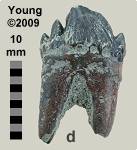 "Mako" teeth were fairly plentiful with Bruce Hargreaves and Eric Sadorf both finding an Isurus oxyrinchus. BJ Blake had her best pair of glasses on, finding a Notorhynchus parasymphyseal; so did Mike Morgan of the Calvert club, finding what was believed to be a seal molar (Image D).
"Mako" teeth were fairly plentiful with Bruce Hargreaves and Eric Sadorf both finding an Isurus oxyrinchus. BJ Blake had her best pair of glasses on, finding a Notorhynchus parasymphyseal; so did Mike Morgan of the Calvert club, finding what was believed to be a seal molar (Image D).
Herbie Ford of the SC Fossil Society excavated part of a baleen whale skull and at least four associated vertebrae. Cetaceans were also represented by two Squalodon canines, found by Becky Hyne. Finally, the author recovered two fused caudal-most vertebra (Image C) from a tuna (Thunnus sp.)
|
| April 5, 2009 |
|
Weekend 6 - Better Weather, Slower collecting
BJ Blake reports: Saturday's weather was absolutely beautiful, even with 20 mph wind all day -- a cool morning developed into a mild afternoon. Joining in the day's hunt were visitors from Old Dominion University (VA), National Aquarium (DC), Gem, Mineral and Lapidary Society of Virginian Peninsula, a number of other clubs and individuals.
Carcharocles megalodon teeth were not as much in evidence as past weekends, but Brian Roberts managed to find a flawless "silver" posterior measuring 2-1/2 by 2-1/2 inches. Not to be outdone, Clayton Smith brought out a 2-inch C. chubutensis & 3-3/4" sperm whale tooth and Jo Carol Titmas showed off a 2-1/2" chubbie & 2-7/8" meg.
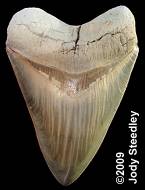 Jim Dziczkowski from Midland Valley Fossil Club (SC) found an impressive 3-inch Cosmopolitodus hastalis, Don Carr a lovely 2-1/2" specimen and Savannah Harris a gorgeous blond and blue/black 1-5/8" Isurus oxyrinchus. Some first timers found many things to please them: Jacob Davenport from Black River fossils a 2 1/8" C. hastalis and Denmark's Vitus Bilking a whale humerus with obvious feeding damage. Henry Wade came out with an upper Notorynchus in matrix, Wayne Bowman a large tautog lower pharyngeal, and Alex Laskovitch a seal molar with both roots intact & slight wear on the crown. Candace found a very unusual bird bone that has yet to be identified.
Jim Dziczkowski from Midland Valley Fossil Club (SC) found an impressive 3-inch Cosmopolitodus hastalis, Don Carr a lovely 2-1/2" specimen and Savannah Harris a gorgeous blond and blue/black 1-5/8" Isurus oxyrinchus. Some first timers found many things to please them: Jacob Davenport from Black River fossils a 2 1/8" C. hastalis and Denmark's Vitus Bilking a whale humerus with obvious feeding damage. Henry Wade came out with an upper Notorynchus in matrix, Wayne Bowman a large tautog lower pharyngeal, and Alex Laskovitch a seal molar with both roots intact & slight wear on the crown. Candace found a very unusual bird bone that has yet to be identified.
I would like to add a safety note here as the boundary stakes had to be moved again today due to reclamation (and will have to be moved again). To all future hunters, please remember that even though the stakes might be placed closer than the 300 feet required for safety, the 300 foot distance must still be maintained.
Editor's note: BJ was kind enough to fill in for our rather-be-fishin' reporter who's busy seeking comparative material from offshore reefs. The accompany meg image (4-inch class) from last weekend was provided by Jody Steedly after the mud was removed. A Sunday report awaits a volunteer.
Tracey Mayo reports: Sunday's weather was perfect for collecting with temperatures in the mid 70's and a light wind. The day's hunt consisted of the Tidewater Gem and Mineral Society, Educators for Excellence Fossil Club (NC), Columbia Gem and Mineral Society (SC) and individual hunters.

Lloyd Schiffelbian found a 2-7/8 inch Pungo Carcharocles and Rick Carter Jr. a 3-inch broad-form hastalis. Robin Stoughton had a bag full (approx. 15-20) of associated whale teeth; they were so fragile that we didn't get an accurate count or picture. Chris Mayo found three associated delphinid (?Tursiops, see image) teeth while other hunters hauled off buckets full of vertebrae & whale bones and numerous small teeth. George Oliver, with the help of three very strong hunters, carried out a petrified log. Everyone was rewarded with the opportunity to collect at Lee Creek.
|
| March 29, 2009 |
|
Weekend 5 - The Weather Empire Strikes Again
Pat Young reports: In spite of nice summer-like temperatures, the weather forecast for Weekend 5 was certainly not encouraging — rain, wind, tornados threatened both days. Saturday turned out to be just fine for collecting until a 2:30 rain sent collectors hurrying back to the bus. Sunday's weather was a study in contrasts — a nice start to the day followed by heavy wind and rain at 10am. Candace's radar (yes Dorothy, some are better Boy Scouts than others) showed a huge red spot over the entire area. We quickly departed the mine only to be blessed by warm sunshine in the parking lot minutes later. Although we were all disappointed, we are learning to accept North Carolina's recent weather patterns.
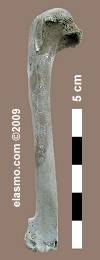 On Saturday, visitors included the Tar Heel Gem and Mineral Society (NC), Black River Fossils (SC), North Coast Fossil Club (OH) and Alabama Mineral and Lapidary Society. Sunday's collectors consisted of Tampa Bay Fossil Club (FL), Dahlgren Fossil Club (VA), The Fossil Forum (an Internet fossil club), American Fossil Federation (MD) and East Coast Fossil Club (NC) and individual visitors. Mud was a determining factor both days in preventing good images.
On Saturday, visitors included the Tar Heel Gem and Mineral Society (NC), Black River Fossils (SC), North Coast Fossil Club (OH) and Alabama Mineral and Lapidary Society. Sunday's collectors consisted of Tampa Bay Fossil Club (FL), Dahlgren Fossil Club (VA), The Fossil Forum (an Internet fossil club), American Fossil Federation (MD) and East Coast Fossil Club (NC) and individual visitors. Mud was a determining factor both days in preventing good images.
Saturday's trip treated Talban Kantala to a once in a lifetime find — 22 associated and mostly complete (about 6 inch) sperm whale teeth. After finding the first, he continued digging in hopes of more; their fragile condition made parking lot imaging unwise. Other exciting finds over both days were: Edward Bronish's 4-1/2 inch re-worked C. megalodon, Brian Hempy's 4-inch meg (and two smaller), Lee Cone's 3-incher, Nando Musmarra's 4-incher (he also got a beautiful Parotodus benedini lateral from a footprint, see image) and Mike Roiland's very impressive black chubutensis. Kim Turok managed to find a beautiful blond posterior bramble and Russ Byers, two Carcharodon carcharias. Yorktown sediments gifted this reporter with a small Megachasma anterior (image). Pungo makos seemed to show themselves a bit more this weekend — several very large anteriors were reported.

Other neat finds this weekend included: shark rostral node and Arbacia improcera (echinoid, Diana Fattori), seal canines (George Powell and Brian Roberts), ?Auk humerus (Brian Hempy), 12 inch section of a Squalodon whitmorei jaw with broken teeth (Rocky Culbertson), and a ?dolphin vertebra in limestone matrix (Howie Cohn, image of valiant effort). Several people struggled with the weight of huge whale vertebrae destined as "gifts" to those not able to visit Aurora. With rain hampering afternoon show and tell, it was difficult to get accurate fossil news — some outstanding finds were surely overlooked.
Editor's note: Pat will be away next weekend so coverage will be less comprehensive. Those visiting on Weekend 6 are encouraged to forward comments or images for the news to elasmo.com.
|
| March 21, 2009 |
|
Weekend 4 - Weather or not
Pat Young reports: Saturday's weather produced strong North winds all day. Although afternoon temps rose to the mid-fifties, the wind chill kept most people somewhat uncomfortable. This cooler weather had kept the mine wet in places, making fossil collecting a muddy adventure in some areas. The fossil take for the day was lighter than expected this early in the season. Aurora Fossil Club members and unaffiliated individuals made the day's hunt.

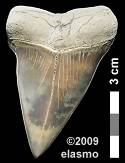 Only one large complete meg was reported -- a nice 3-3/4 inch lower by Dawn Riggestad. Bob Werner found a pretty 2-inch blue & gray chubutensis lateral and Frank Elder an extreme posterior with cusplets nearly as large as the main cusp. By far, the most abundant "large" teeth of the day were broad-form Cosmopolitodus hastalis. A few in the near three inchers (image of Troy Lee's) were found as well as many only slightly smaller. Other Yorktown teeth seemed in short supply. Pungo collectors fared a bit better but not by much. Danni Cress got a pretty upper hastalis (narrow-form) in matrix. Jeff Sparks chipped-out a decent 4" whale tooth, complete with enamel tip, from Pungo limestone. Other interesting finds included a large whale humerus, several Pungo ray dermal denticles, a split-tip Carcharhinus tooth and a section of wahoo jaw with three teeth. Frank Elder reported a Squalodon molar. Only one large complete meg was reported -- a nice 3-3/4 inch lower by Dawn Riggestad. Bob Werner found a pretty 2-inch blue & gray chubutensis lateral and Frank Elder an extreme posterior with cusplets nearly as large as the main cusp. By far, the most abundant "large" teeth of the day were broad-form Cosmopolitodus hastalis. A few in the near three inchers (image of Troy Lee's) were found as well as many only slightly smaller. Other Yorktown teeth seemed in short supply. Pungo collectors fared a bit better but not by much. Danni Cress got a pretty upper hastalis (narrow-form) in matrix. Jeff Sparks chipped-out a decent 4" whale tooth, complete with enamel tip, from Pungo limestone. Other interesting finds included a large whale humerus, several Pungo ray dermal denticles, a split-tip Carcharhinus tooth and a section of wahoo jaw with three teeth. Frank Elder reported a Squalodon molar.

Although the collecting area is very large and has an abundance of good Yorktown and Pungo tailings, it needs much more weathering. Regular heavy rain and a decent drying period in between should allow collecting conditions to improve. This spring's most prolific fossil bounty just might come toward the end of the season.
[Unless something spectacular is found, there will be no report on Sunday's results; the editor is headed for Key West and the reporter given the day off to catch the Bristol race.]
Sunday supplement. I didn't expect to provide Sunday news, but proactive contributions permitted a quick overview, albeit belatedly. Fred Plumb wrote:
The weather was very pleasant with a slight breeze and temperatures in the low to mid 60's. 38 people were on this trip {Midland Fossil Club, SC & National Capitol Fossil Club, DC] with about 12 first-timers to the mine. Although numerous footprints were present from Saturday's group, several good finds appeared:
* Diana Fattori (visiting from Italy with her husband) found a flawless Yorktown megalodon - a lower lateral in the four-inch range; she was delighted, and all others who saw it were quite impressed. A second beautiful four-inch Yorktown meg was found by another collector.
* Spyros Skouras and Justin Hurst (each on their first hunt into the mine) got great Carcharodon carcharias teeth; both were nearly flawless with complete roots.
* Alan Shingler picked two cow shark teeth -- a gorgeous Hexanchus upper was the showpiece.
* Jim Savia found a beautiful 1.75 inch Hemipristis serra.

Supplementary images were provided by Anne Lineberry (Jennifer William's whale vertebra, new ramp & Cissy Hanna's meg tooth), Nando Musmarra (Diana Fattori's shark centrum with cartilage and meg) and Kurt Wenk (meg in matrix).

|
| March 14, 2009 |
|
Weekend 3 - Rained-out
Pat Young reports: Despite a repaired ramp, PCS was required to cancel fossil collecting again this weekend due to inclement weather.
The old (unofficial) policy of collecting in the rain should no longer be taken for granted. Our access roads are heavily used by the mine equipment; when wet they are difficult to travel by bus. The hills are steeper (and more slippery) than we had in the "old days" and the water is very much deeper. Collectors should monitor the weather and call the fossil museum (252-322-4238) to confirm whether a trip will be held on rainy days. There are no make-up dates available to anyone who is cancelled.
|
| March 8, 2009 |
|
March purrs on
Pat Young reports: Members of the North Carolina Fossil Club, Delaware Valley Paleontological Society, Beaufort (NC) Maritime Museum and Southwest Florida Fossil Club shared the weekend's slots with non-club affiliated fossil collectors. The weather both days was summer-like (78-82 deg.) with typical brisk March breezes and sunny skies.

Steve Kurth's (DVPS) efforts (or more likely lucky stars) got him the largest (4-1/2) complete Carcharocles megalodon of the the weekend. Many very nice but smaller ones were found, including those by Jeff McGrady (3-5/8"), Tracey Mayo (3-1/2"), Jerry Messick (3-1/4", image E), and Craig Healy (3"). Reggie Titmas had a pretty reddish brown specimen and Richard Chandler's posterior was fantastic. Steve McCloskey got a beautiful tan C. chubutensis in matrix while Lisa Blanton's 5-1/4" black re-worked tooth came in two pieces. Cosmopolitodus hastalis collectors did very well; several in the three inch range were found including Clint Nietshmann's lower (image D) and Dale Healy's nicely patterned upper. Michael Ford and Jason Nietshmann each got 2-1/4 inch Parotodus benedini teeth; Michael's was a light tan color while Jason's was a very shiny black (image C). Seven Carcharodon carcharias teeth were found. The fresh tailings haven't allowed many smaller teeth to be exposed in any abundance, although several people showed off some nice Pungo porpoise and dolphin teeth. John Everette got a nice Hexanchus upper and a few Notorynchus lowers were collected. The Pungo also gifted Becky with a perfect bramble shark tooth. Other outstanding finds of the weekend include Tracey Mayo's whale tooth, a hefty chunk of fossil wood with tereba worm bore holes filled with quartz (Rick Bennett), seal molar (Valarie Woods, image A) and a crocodile tooth (image B) found by Larry Decina.
The spreader spoils are beginning to encroach a little bit in our collecting area (Becky had to relocate a few stakes on Saturday) but the area is quite large and we should have plenty of room to finish the season.
|
| March 1, 2009 |
|
A wet start
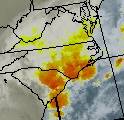 Pat Young reports: Opening day weather for spring fossil season was not exactly a collector's dream. Dark skies, cold drizzling rain and gusty winds prevailed the entire day. Temps dropped 12 degrees between noon and 1pm accompanied by a brief period of sleet. Our trusty fossil bus balked at the weather (it refused to start) but some quick negotiations by Curtis Ormond got us alternative transportation. In spite of these obstacles, the parking lot atmosphere was gay and hopeful. Collectors heeded weather advisories; the uniform of the day included raincoats for all. My rain-soaked camera was good for only one image and then it died. Sunday's trip was cancelled due to worsening weather forecasts. Pat Young reports: Opening day weather for spring fossil season was not exactly a collector's dream. Dark skies, cold drizzling rain and gusty winds prevailed the entire day. Temps dropped 12 degrees between noon and 1pm accompanied by a brief period of sleet. Our trusty fossil bus balked at the weather (it refused to start) but some quick negotiations by Curtis Ormond got us alternative transportation. In spite of these obstacles, the parking lot atmosphere was gay and hopeful. Collectors heeded weather advisories; the uniform of the day included raincoats for all. My rain-soaked camera was good for only one image and then it died. Sunday's trip was cancelled due to worsening weather forecasts.

Over a half mile across, extending all the way to the opposite highwall, and about 1/2 mile wide, the all new collecting area is the largest (and best) we've had for many years. The ramp extends with a dozer track running midway into the mine -- the best we've ever had. We'd like to thank Tex Gilmore and Rob Jenner for the labor and expense involved to provide us with this great access and area. Dragline operators must be listening to our prayers, large Yorktown and Pungo River deposits are well separated; upper shell beds are much less visible than in past seasons.
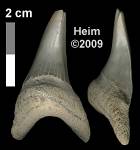 Friends of the Museum got first day slots. A few more adventurous collectors hiked to the farthest boundaries but most collected nearer hills. In spite of extremely muddy conditions, fossil finds were surprisingly abundant and varied. Amy Kowinsky recovered a massive Carcharocles megalodon; although missing its tip, it measured 5 inches high with a width to match. A complete 5-incher was found by David Griffith. Many other smaller megs and chubbies were collected (some people got several). Carcharodon carcharias teeth were represented by John Everette's 2-1/2 inch upper and Kevin May's slightly smaller lower. Four Parotodus benedeni teeth were recovered: a nearly 3-inch upper anterior (Talban Kantala), juvenile (Mike Keklak), lateral (Dave Sanderson) and a lower A2 (figured) from pit-car tailings (Bill Heim). Jason Kowinsky and Marco Gulotta each found beautiful & complete lower Hexanchus teeth. Friends of the Museum got first day slots. A few more adventurous collectors hiked to the farthest boundaries but most collected nearer hills. In spite of extremely muddy conditions, fossil finds were surprisingly abundant and varied. Amy Kowinsky recovered a massive Carcharocles megalodon; although missing its tip, it measured 5 inches high with a width to match. A complete 5-incher was found by David Griffith. Many other smaller megs and chubbies were collected (some people got several). Carcharodon carcharias teeth were represented by John Everette's 2-1/2 inch upper and Kevin May's slightly smaller lower. Four Parotodus benedeni teeth were recovered: a nearly 3-inch upper anterior (Talban Kantala), juvenile (Mike Keklak), lateral (Dave Sanderson) and a lower A2 (figured) from pit-car tailings (Bill Heim). Jason Kowinsky and Marco Gulotta each found beautiful & complete lower Hexanchus teeth.
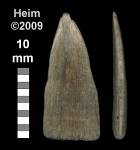 Other outstanding finds included: an associated whale periotic and bulla (Lee Cone),
Squalodon incisors & molars (Bill & Montine Heim, David Griffith and Dawn Mosteller), three associated Tursiops teeth (Shannon Roberts), crocodile tooth (Don Muller), ray dermal scutes (BJ Blake & Shannon Roberts), seal astragalus (Dave Grabda) and 8 associated fish vertebrae (Doug Chaussee, he also reported the only seal tooth). Bill Heim found a very nice Anoxypristis rostral spine (figured) in lower Pungo rock debris. In addition to the heavily-collected whale vertebrae, several seal and walrus limb bones were taken home. Other outstanding finds included: an associated whale periotic and bulla (Lee Cone),
Squalodon incisors & molars (Bill & Montine Heim, David Griffith and Dawn Mosteller), three associated Tursiops teeth (Shannon Roberts), crocodile tooth (Don Muller), ray dermal scutes (BJ Blake & Shannon Roberts), seal astragalus (Dave Grabda) and 8 associated fish vertebrae (Doug Chaussee, he also reported the only seal tooth). Bill Heim found a very nice Anoxypristis rostral spine (figured) in lower Pungo rock debris. In addition to the heavily-collected whale vertebrae, several seal and walrus limb bones were taken home.
Mine visitors are encouraged to stay up to date on weather forecasts before their trip . The fossil bus is not equipped with 4-wheel drive and muddy roads can become un-navigable.
|
| February 19, 2009 |
|
Season Scheduled
The 2009 spring fossil season at PCS Phosphate-Aurora will commence Feb. 28 and continue through May 9th. First weekend slots will consist of Friends of the Museum members, with clubs, individuals and remaining Friends members filling later dates. The required paperwork has been updated slightly for this season but remains essentially the same as in past years. If you dont have a hard hat, PCS will furnish one but the required steel-toed shoes are the responsibility of the collector. Company furnished goggles are still required to be worn on all hard hats so pick up a pair when you get your hat. Please dont show up in shorts, capris, or tank tops as you'll be turned away. Check-in time remains 7:30am.
Although rain has caused a bit of delay, our fossil ramp is in the final stages of completion. We have very large and all new collecting area that should allow for future reclaimation advances with no problems. According to Tex Gilmore, PCS Chief Geologist, this looks to be some of the best fossil tailings he has seen in a long time.
|
| January 15, 2009 |
|
Urgent -- Resend Required
Curtis Ormond (PCS Public Affairs) advised that the folder containing Spring Season requests received between 00:01 and 08:00 this morning was accidentally deleted; these early-bird requests need to be resubmitted.
I might suggest that you include "re-send" in the "Subject" line and use the "Forward" option from your "Out Box", it should maintain the original "time stamp".
|
| January 8, 2009 |
|
Spring Season
Curtis Ormond of PCS Public Affairs wrote: Just received official word on the Spring Season; I will start accepting requests on January 15 at midnight. We will make every attempt to include the folks that got canceled in the fall; plans are to bring them in first. They are working on building a new ramp and we will train our guides and helpers next month. We hope the season is good for everyone and appreciate your understanding when we had to stop last fall.
Curtis will take email requests only. Please contact him at cormond@pcsphosphate.com to reserve a date for your group.
The same rules as in previous seasons will apply:
Steel-toed footwear and hard hats are required. All visitors must be 18+, show a photo ID and sign a Waiver of Liability Release. Shorts and sleeveless shirts are not allowed and plenty of water needed. Collectors will meet at (7:00 am) the parking lot across from the PCS Main Gate (from Highway 33 in Aurora, NC take Highway 306 N. for 6 miles).
|
|
|